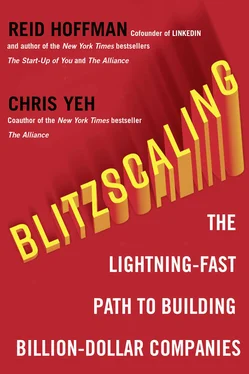The speed of the Internet has generated a number of second-order effects that have changed how businesses and organizations can grow. For example, the Internet has made it possible to access global markets and tap into massively scalable distribution channels in a way that wasn’t feasible during earlier eras. But perhaps the most important impact for businesses has been the rising significance and prevalence of so-called network effects that occur when increased usage of a product or service boosts the value of that product or service for other users. For example, each additional Airbnb host makes the service a tiny bit more valuable for every other Airbnb guest and vice versa. Each additional WeChat user makes the service a tiny bit more valuable for every other WeChat user, and so on.
Network effects generate a positive feedback loop that can allow the first product or service that taps into those effects to build an unassailable competitive advantage. For example, eBay was founded in 1995, yet network effects keep it a dominant player in peer-to-peer commerce two decades later. Airbnb offers over three million listings in sixty-five thousand cities around the world; think of how difficult it would be for a new entrant to offer anywhere close to the same selection and value.
We’re reminded of the famous scene from the movie Glengarry Glen Ross, in which Alec Baldwin’s character, Blake, is speaking to a group of salesmen:
As you all know, first prize is a Cadillac Eldorado. Anyone wanna see second prize? Second prize is a set of steak knives. Third prize is you’re fired. Get the picture?
First prize in the first wave of consumer social networking went to Facebook; second prize to MySpace; third prize to Friendster. Remember Friendster? You need to win first prize in order to survive in the Internet era.
The level of competition can seem overwhelming at times, but the Networked Age also allows companies to reap incredible rewards much more rapidly than at any other point in history. We call the strategy and mindset they can use to get there “blitzscaling.”
Blitzscaling is a strategy and set of techniques for driving and managing extremely rapid growth that prioritize speed over efficiency in an environment of uncertainty. Put another way, it’s an accelerant that allows your company to grow at a furious pace that knocks the competition out of the water.
Blitzscaling requires hypergrowth but goes beyond the blunt strategy of “get big fast” because it involves purposefully and intentionally doing things that don’t make sense according to traditional business thinking. In the Blitzscaling Era, you have to make a tough call:
Take on the additional risk and discomfort of blitzscaling your company,
Or accept what might be the even greater risk of losing if your competition blitzscales before you do.
Was Airbnb’s decision to expand into European markets—a move that could have stretched the company so thin as to destroy its core business—either efficient or certain? Hardly. Airbnb could easily have failed, burning through all its capital while essentially ceding the European market to its copycat competitor Wimdu. Yet the risky decision proved the right one.
Blitzscaling disrupts entire industries, such as music, video games, and telephony, with both new technologies and new business models … and those are examples from just a single company. (You know, the one that produced the iPod, iTunes, the iPhone, and the iPad, to name just a few.) These waves of disruption affect every aspect of our daily lives, from the jobs we work, to the products we use, to the way we connect with one another.
Disruption on its own is neither good nor bad, but it always involves change. Replacing a $10 product with a $1 product of equal or better quality looks like a disaster to an incumbent player, but, for society as a whole, it means greater productivity. The buyer gets the desired product, and now also has $9 available to invest in other things. Netflix has been bad news for broadcast and cable networks, but it has been great news for fans and creators of movies and television. Yes, disruption produces losers as well as winners, but, as a whole, it is a vital source of growth and opportunity that you can’t afford to ignore.
It’s good to keep in mind that those who extoll the virtues of disruption tend to be—coincidentally enough—the ones in the winners’ circle. But disruption that spreads its benefits and new opportunities broadly is better for society. Fortunately, most disruption falls into this category. In a 2004 working paper, “Schumpeterian Profits in the American Economy: Theory and Measurement,” Yale economist William Nordhaus examined the US economy from 1948 to 2001. Based on the data he collected, he concluded that only 2.2 percent of “profits that arise when firms are able to appropriate the returns from innovative activity” went to the disrupters. “Most of the benefits of technological change are passed on to consumers rather than captured by producers,” he concluded. Like it or not, change is inevitable—but it doesn’t have to be wholly unexpected.
In their book Future Shock, the futurists Alvin and Heidi Toffler wrote that “change is the only constant,” and “to survive, to avert what we have termed future shock, the individual must become infinitely more adaptable and capable than ever before.” Those words were originally published in 1970. The pace of change has only accelerated since then.
Everyone should have the opportunity to learn how blitzscaling works, because it is already impacting their lives. And once they know how it works, they can use it to reshape the world. People should be part of building the future rather than feeling like the future is being forced upon them.
Blitzscaling is what separates the start-ups that get disrupted and disappear as the world changes from the ones that scale up to become market leaders and shape the future.
This book was born out of a class we taught at Stanford in which we dissected the process that went into growing the world’s largest technology companies and then codified a series of tactics and choices that made it work. The result was a specific set of principles that describes how to grow multibillion-dollar companies in a handful of years.
While writing this book, we talked to hundreds of entrepreneurs and CEOs, including those of the world’s most valuable companies, such as Facebook, Alphabet (Google), Netflix, Dropbox, Twitter, and Airbnb. (You can hear a number of these conversations on my podcast, Masters of Scale .) Even though the stories of their companies’ rise were very different in many ways, the one thing they all had in common was an extreme, unwieldy, risky, inefficient, do-or-die approach to growth.
In this book, we draw lessons from these world-leading companies to explain the nuts and bolts of how to blitzscale, when to blitzscale, why to blitzscale, and the global impact of the companies that are blitzscaling all around you right this second.
This quest will take us all over the globe, but one place in particular stands out.
SILICON VALLEY: THE PERFECT PLACE TO DECODE BLITZSCALING
Although companies have successfully blitzscaled on every continent except for Antarctica, the most prominent and most concentrated set of examples comes from California’s Silicon Valley. And while we can’t simply copy and paste the techniques that work in Silicon Valley and expect them to work the same way in Shanghai, neither can we cut and paste from Shanghai to Stockholm, nor from Stockholm to São Paulo. Instead, we try to extract some universal lessons and then explore how they apply across the world.
As of this writing at the end of 2017, there are only fourteen publicly traded technology companies in the world that have a market capitalization of over $100 billion. Want to guess how many of those are in Silicon Valley? Seven—that’s half of the world’s most valuable tech companies.
Читать дальше












